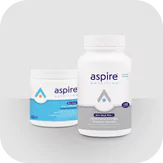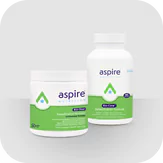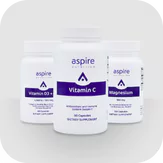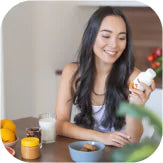Bio-Clear Detoxification Powder
Bio-Clear Detoxification Powder
Bio-Clear is designed to support the body’s natural detoxification and antioxidant systems. This comprehensive formula harnesses the power of sulforaphane (SFN) and combines BroccoRaphanin®, a patented broccoli seed extract rich in glucoraphanin and 3x more bioavailable than commercial broccoli seeds, with a potent myrosinase enzyme blend from white mustard seed and cruciferous vegetables. White mustard seeds have been studied and shown to increase the bioavailability of sulforaphane by four times. Sulforaphane has been studied for its neuroprotective properties and its role in supporting healthy cognitive and behavioral function, as well as overall cellular health. In addition to sulforaphane’s indirect antioxidant effects, the formula includes bilberry fruit extract for direct, robust antioxidant support.
Easy-to-mix, quick-to-dissolve, unflavored powder with no added sugars or artificial flavors—subtle enough even for picky eaters. Specially formulated for individuals sensitive to taste and texture.
30 Scoops - Up to 60 Day Supply Depending on Weight
Benefits of Bio-Clear
-
Natural Detox*
Bio-Clear combines powerful and natural detox substances with super concentrated antioxidants. Our formula is packed with ingredients that contain the essential elements (glucoraphanin) and enzymes (myrosinase) that stimulate nature’s most potent detoxification substance ever identified, sulforaphane. -
Immune Support*
Helps to optimize and maintain a healthy immune response.* -
Anti-Inflammatory Support*
Supports a healthy inflammation response.* -
Chemoprotective*
The cellular mechanisms linked to the biological activity of BroccoRaphanin® include a chemoprotective effect that is ascribed to sulforaphane. The chemoprotective effects of vegetables from the Brassica family, such as broccoli, are well documented. Scientific research into the mechanism of action highlights mainly the conversion of the precursor glucoraphanin and sulforaphane (SF) by an enzyme present in the gut microflora, myrosinase. -
Healthy Aging*
Aids your body's natural defense against oxidative stress, free radicals, and cell damage.* -
Autism Support*
Sulforaphane has been clinically proven to show results in Autism. Studies have shown improvements in social interaction, verbal communication, and behavior (such as irritability, repetitive movements, hyperactivity). Ref: http://www.pnas.org/content/111/43/15550

Why Should I Detox Daily?
The simple answer, “because toxins don’t take days off.”
Every day we get bombarded with dangerous toxins that quietly wreak havoc on our bodies compromising mental and physical development and performance.
Toxins are everywhere and inside just about everything we touch and taste; in our food, drinks, water, air, household products, cosmetics, clothing, and furniture.
Even most so-called healthy foods are infested with harmful pesticides and toxins.
There’s really no way to avoid them.
So you need to give your body what it needs to fight against toxins.
Multiple Detoxification Pathways
Sulforaphane - Nature's Most Powerful Detoxifier
Sulforaphane is one of nature's most potent detoxifiers ever identified. Our formula is packed with ingredients that contain the essential elements (glucoraphanin) and enzymes (myrosinase) that stimulate the production of sulforaphane. Sulforaphane also stimulates the production of glutathione, natures most powerful antioxidant.
Sulforaphane induces the body’s natural detoxification system enzymes. These enzymes eliminate many types of free radicals and environmental pollutants and trigger antioxidant action.
Sulforaphane enhances the production of glutathione, a critical antioxidant in the body, by up-regulating enzymes necessary for its synthesis and re-synthesis. This increased availability of glutathione in the body's cells is significant for overall detoxification processes.
Glutathione is a powerful antioxidant that plays a vital role in binding with toxins, including pesticides, aflatoxins, and air pollutants, forming compounds known as mercapturic acids. These compounds are then excreted in urine, representing a key mechanism for removing toxic substances from the body.
Clinically Researched & 3X Potency
BroccoRaphanin®'s benefits are supported by clinical data and has been shown to more than triple the potency of commercial broccoli seed.
BroccoRaphanin® is a patented broccoli seed extract. It is a natural, highly concentrated source of glucoraphanin, which is the starting point for sulforaphane production.
Research has also shown eating broccoli alone does not contain enough of the compounds to be effective and the cooking process can render the enzyme needed for the conversion to sulforaphane ineffective.
Myrosinase Blend = 4X the Power!
The amount of glucoraphanin that can be converted to sulforaphane is limited to the amount of myrosinase available. Which is why we included a power house 4-ingredient myrosinase blend.
Our unique formula increases the production, bioavailability, and effectiveness of sulforaphane, 4x more than most other sulforaphane based supplements.
Myrosinase Blend:
- White Mustard Seed
- Brassica oleracea var. gemmifera Leaf (Brussel Sprouts)
- Collards Leaf (Collard Greens)
- Wasabi Root
This blend is a potent source of myrosinase, aka the enzyme/activator that turns BroccoRaphanin® into sulforaphane.
Bilberry Fruit Extract - Super Antioxidant
Bilberries are a super concentrated, natural supply of antioxidants, anthocyanins and polyphenols, provide nutrients that help the body cope with stress, support immunity, and promote gut health. Bilberries have 4x higher antioxidant levels than blueberries.
Supplement Facts
Servings Per Container: 30
Flavor: Unflavored


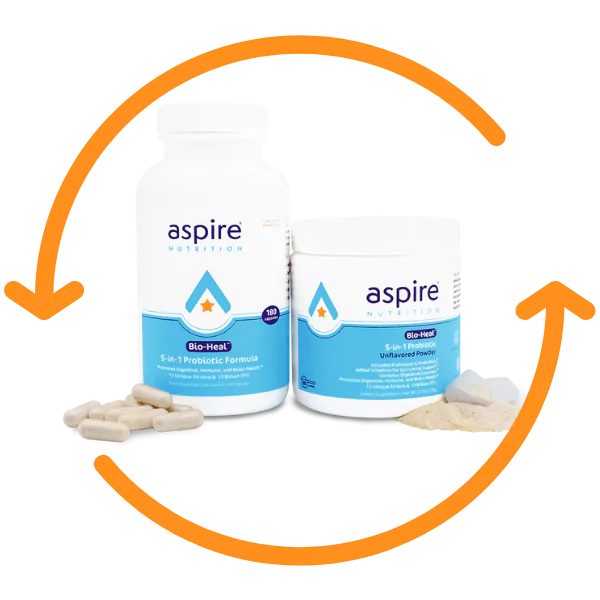

Your Routine on Repeat
Subscribe to your favorite Aspire Nutrition supplements and save 10% on every order, plus free domestic shipping on orders of $70 or more, and more!

Best Decision!
- Melissa L.
Frequently Asked Questions
What does Bio-Clear do?
Bio-Clear is designed for daily detoxification, it is not intended for heavy metal detoxification.
On a daily basis, our bodies encounter toxins present in our food, beverages, the atmosphere, pollution, vehicle emissions, as well as common household items such as cosmetics, plastics, adhesives, and furniture. Even when we exercise caution, avoiding these toxins can be quite challenging. Additionally, some individuals may have genetic factors that make natural detoxification more challenging for them.
Bio-Clear does NOT contain binders or chelating agents. Bio-Clear is a sulforaphane based detox product. Bio-Clear contains ingredients high in glucoraphanin and myronaise, which when consumed are converted to sulforaphane.
Sulforaphane induces the body’s natural detoxification system enzymes. These enzymes eliminate many types of free radicals and environmental pollutants and trigger antioxidant action. Sulforaphane enhances the production of glutathione, a critical antioxidant in the body, by up-regulating enzymes necessary for its synthesis and re-synthesis. This increased availability of glutathione in the body's cells is significant for overall detoxification processes.
Glutathione is a powerful antioxidant that plays a vital role in binding with toxins, including pesticides, aflatoxins, and air pollutants, forming compounds known as mercapturic acids. These compounds are then excreted in urine, representing a key mechanism for removing toxic substances from the body. Glutathione has the capacity to bind to various heavy metals, facilitating their excretion. So, sulforaphane (the main mechanism behind Bio-Clear) may facilitate the detoxication of heavy metals by increasing glutathione synthesis.
These nutrients provide your body with the necessary support to combat toxins, manage stress, bolster immunity, and enhance overall health and gut well-being. Importantly, it's worth noting that Bio-Clear does not contain any addictive components, allowing you to discontinue its use at any time.
What are the ingredients and allergen information for Bio-Clear?
Please refer to the supplement fact panel image using the link provided below:
Bio-Clear is free of gluten, wheat, soy, and GMO ingredients, making it suitable for vegans.
Bio-Clear does not contain peanuts or tree nuts, although it's important to note that the facility is not certified as nut-free or peanut-free. Currently, there are no nut or peanut-containing products processed in the facility.
What is the serving information for Bio-Clear?
Bio-Clear is suitable for both children and adults aged 4 and older.
The serving size is determined based on the Recommended Daily Allowances for individuals aged 4 and above, which is a mandatory guideline. However, it's worth noting that some of our customers choose to halve the recommended serving size for children under the age of 4 or those who weigh less than 50 pounds. We always advise consulting with your healthcare provider if you have specific questions or concerns regarding your child's nutritional requirements.
Powder:
Under 100 lbs: 1/2 scoop daily.
Over 101 lbs: 1 scoop daily.
*If the scoop is missing or lost: Under 100 lbs: 1/4 tsp daily. Over 101 lbs: 1/2 tsp daily.
We recommend incorporating Bio-Clear into your daily routine whenever possible, as consistency is crucial.
Bio-Clear is a natural supplement that you can continue taking for as long as you find it to be advantageous.
Are there mixing or serving tips for Bio-Clear?
Bio-Clear can be mixed into a smoothie or fruit juice successfully!
We have had customers report they had success mixing Bio-Clear into grape, apple, cherry, and cran-apple juices. Another customer has reported mixing in an actimel yogurt smoothie. Strawberry and blueberry smoothies have also been a customer favorite. A few parents have reported mixing Bio-Clear in your childs morning cereal with great success. Just make sure they drink the milk at the end!
Another option we received from a customer is to mix the powder into a light colored juice like apple or orange and see what color you can make, like a science experiment as the powder changes to a purple color!
We suggest using a small hand held milk frother to mix the powder completely.
If color is a problem for your child you can also try serving in a non see thru cup with lid and straw. One customer said they used a stainless steel cup with stainless steel straw.
You can sift the powder into the liquid beverage to prevent any clumping.

How long can Bio-Clear be taken for?
Bio-Clear is a natural supplement and can be taken as long as you find it beneficial.
Are there any expected reactions to Bio-Clear?
At this time there are no known adverse reactions or side effects. As with any dietary supplement we recommend consulting your healthcare practitioner.
How should Bio-Clear be stored?
Bio-Clear should be stored in a cool, dry place.
What research and studies went into making this product?
Our team of experts and scientists formulate each product with the use of extensive research. We rely on a body of studies to make sure we’re using the best ingredients to support our customers health and well-being.:
References:
1) Pasca, S. P., Nemes, B., Vlase, L., Gagyi, C. E., Dronca, E., Miu, A. C., & Dronca, M. (2006). High levels of homocysteine and low serum paraoxonase 1 arylesterase activity in children with autism. Life Sciences, 78(19), 2244-2248. https://doi.org/10.1016/j.lfs.2005.09.040
2) Gaita, L., Manzi, B., Sacco, R., Lintas, C., Altieri, L., Lombardi, F., Pawlowski, T. L., Redman, M., Craig, D. W., Huentelman, M. J., Ober-Reynolds, S., Brautigam, S., Melmed, R., Smith, C. J., Marsillach, J., Camps, J., Curatolo, P., Persico, A. M., & Glessner, J. T. (2010). Decreased serum arylesterase activity in autism spectrum disorders. Psychiatry Research, 180(2-3), 105-113. https://doi.org/10.1016/j.psychres.2010.04.010
3) Buyske, S., Williams, T. A., Mars, A. E., Stenroos, E. S., Ming, S. X., Wang, R., Sreenath, M., Factura, M. F., Reddy, C., Lambert, G. H., & Johnson, W. G. (2006). Analysis of case-parent trios at a locus with a deletion allele: association of GSTM1 with autism. BMC Genetics, 7, 8. https://doi.org/10.1186/1471-2156-7-8
4) James SJ, Melnyk S, Jernigan S, Hubanks A, Rose S, Gaylor DW. Abnormal transmethylation/transsulfuration metabolism and DNA hypomethylation among parents of children with autism [published correction appears in J Autism Dev Disord. 2008 Nov;38(10):1976. Jill James, S [corrected to James, S Jill]]. J Autism Dev Disord. 2008;38(10):1966-1975. doi:10.1007/s10803-008-0591-5 https://doi.org/10.1002/ajmg.b.30366
5) Rossignol DA, Genuis SJ, Frye RE. Environmental toxicants and autism spectrum disorders: a systematic review. Transl Psychiatry. 2014;4(2):e360. Published 2014 Feb 11. doi:10.1038/tp.2014.4 https://www.ncbi.nlm.nih.gov/pmc/articles/PMC3944636/#bib207
6) Alabdali A, Al-Ayadhi L, El-Ansary A. A key role for an impaired detoxification mechanism in the etiology and severity of autism spectrum disorders. Behav Brain Funct. 2014;10:14. Published 2014 Apr 28. doi:10.1186/1744-9081-10-14 https://www.ncbi.nlm.nih.gov/pmc/articles/PMC4017810/
7) Zhang M, Chu Y, Meng Q, et al. A quasi-paired cohort strategy reveals the impaired detoxifying function of microbes in the gut of autistic children. Sci Adv. 2020;6(43):eaba3760. Published 2020 Oct 21. doi:10.1126/sciadv.aba3760 https://www.ncbi.nlm.nih.gov/pmc/articles/PMC7577716/]
8) Detoxification and Autism - TACA https://tacanow.org/family-resources/detoxification-and-autism/
9) Theoharides TC, Tsilioni I, Patel AB, Doyle R. Atopic diseases and inflammation of the brain in the pathogenesis of autism spectrum disorders. Transl Psychiatry. 2016;6(6):e844. doi:10.1038/tp.2016.77 https://www.ncbi.nlm.nih.gov/pmc/articles/PMC4931610/
10) Main PA, Angley MT, O'Doherty CE, Thomas P, Fenech M. The potential role of the antioxidant and detoxification properties of glutathione in autism spectrum disorders: a systematic review and meta-analysis. Nutr Metab (Lond). 2012;9:35. doi:10.1186/1743-7075-9-35 https://www.ncbi.nlm.nih.gov/pmc/articles/PMC3373368/
11) Egner, P. A., Chen, J. G., Zarth, A. T., et al. (2014). Rapid and sustainable detoxication of airborne pollutants by broccoli sprout beverage: Results of a randomized clinical trial in China. Cancer Prevention Research, 7(8), 813-823. https://pubmed.ncbi.nlm.nih.gov/24913818/
12) Armah, C. N., Traka, M. H., Dainty, J. R., et al. (2013). A diet rich in high-glucoraphanin broccoli interacts with genotype to reduce discordance in plasma metabolite profiles by modulating mitochondrial function. The American Journal of Clinical Nutrition, 98(3), 712-722. https://pubmed.ncbi.nlm.nih.gov/23885049/
13) Russo, M., Spagnuolo, C., Russo, G. L., et al. (2018). Nrf2 targeting by sulforaphane: A potential therapy for cancer treatment. Critical Reviews in Food Science and Nutrition, 58(8), 1391-1405. https://pubmed.ncbi.nlm.nih.gov/28001083/
14) Dinkova-Kostova, A. T., & Abramov, A. Y. (2015). The emerging role of Nrf2 in mitochondrial function. Free Radical Biology and Medicine, 88(Part B), 179-188. https://pubmed.ncbi.nlm.nih.gov/25975984/
15) Singh, K., Connors, S. L., Macklin, E. A., Smith, K. D., Fahey, J. W., Talalay, P., & Zimmerman, A. W. (2014). Sulforaphane treatment of autism spectrum disorder (ASD). Proceedings of the National Academy of Sciences, 111(43), 15550-15555. https://doi.org/10.1073/pnas.1416940111
16) Zimmerman AW, Singh K, Connors SL, et al. Randomized controlled trial of sulforaphane and metabolite discovery in children with Autism Spectrum Disorder [published correction appears in Mol Autism. 2021 Jun 16;12(1):44. doi: 10.1186/s13229-021-00451-9]. Mol Autism. 2021;12(1):38. Published 2021 May 25. doi:10.1186/s13229-021-00447-5 https://pubmed.ncbi.nlm.nih.gov/34034808/
17) Momtazmanesh S, Amirimoghaddam-Yazdi Z, Moghaddam HS, Mohammadi MR, Akhondzadeh S. Sulforaphane as an adjunctive treatment for irritability in children with autism spectrum disorder: A randomized, double-blind, placebo-controlled clinical trial. Psychiatry Clin Neurosci. 2020;74(7):398-405. doi:10.1111/pcn.13016 https://pubmed.ncbi.nlm.nih.gov/32347624/
18) Ou J, Smith RC, Tobe RH, et al. Efficacy of Sulforaphane in Treatment of Children with Autism Spectrum Disorder: A Randomized Double-Blind Placebo-Controlled Multi-center Trial. J Autism Dev Disord. 2024;54(2):628-641. doi:10.1007/s10803-022-05784-9 https://pubmed.ncbi.nlm.nih.gov/36427174/
19) Bent, S., Lawton, B., Warren, T., Widjaja, F., Dang, K., Fahey, J. W., Cornblatt, B., Kinchen, J. M., Delucchi, K., & Hendren, R. L. (2018). Identification of urinary metabolites that correlate with clinical improvements in children with autism treated with sulforaphane from broccoli. Molecular Autism, 9, 35. https://doi.org/10.1186/s13229-018-0218-4
20) McGuinness G, Kim Y. Sulforaphane treatment for autism spectrum disorder: A systematic review. EXCLI J. 2020;19:892-903. Published 2020 Jun 26. doi:10.17179/excli2020-2487 https://www.ncbi.nlm.nih.gov/pmc/articles/PMC7527484/
21) Magner M, Thorová K, Župová V, et al. Sulforaphane Treatment in Children with Autism: A Prospective Randomized Double-Blind Study. Nutrients. 2023;15(3):718. Published 2023 Jan 31. doi:10.3390/nu15030718 https://www.ncbi.nlm.nih.gov/pmc/articles/PMC9920098/
22) Yang J, He L, Dai S, et al. Therapeutic efficacy of sulforaphane in autism spectrum disorders and its association with gut microbiota: animal model and human longitudinal studies. Front Nutr. 2024;10:1294057. Published 2024 Jan 8. doi:10.3389/fnut.2023.1294057 https://www.ncbi.nlm.nih.gov/pmc/articles/PMC10800504/
23) Tarozzi A, Angeloni C, Malaguti M, Morroni F, Hrelia S, Hrelia P. Sulforaphane as a potential protective phytochemical against neurodegenerative diseases. Oxid Med Cell Longev. 2013;2013:415078. doi:10.1155/2013/415078 https://www.ncbi.nlm.nih.gov/pmc/articles/PMC3745957/
24) Calabrese V, Giordano J, Crupi R, et al. Hormesis, cellular stress response and neuroinflammation in schizophrenia: Early onset versus late onset state. J Neurosci Res. 2017;95(5):1182-1193. doi:10.1002/jnr.23967 https://pubmed.ncbi.nlm.nih.gov/27898171/
25) Liu H, Zimmerman AW, Singh K, et al. Biomarker Exploration in Human Peripheral Blood Mononuclear Cells for Monitoring Sulforaphane Treatment Responses in Autism Spectrum Disorder. Sci Rep. 2020;10(1):5822. doi:10.1038/s41598-020-62714-4 https://pubmed.ncbi.nlm.nih.gov/32242086/
26) Houghton CA, Fassett RG, Coombes JS. Sulforaphane and Other Nutrigenomic Nrf2 Activators: Can the Clinician’s Expectation Be Matched by the Reality? Oxid Med Cell Longev. 2016;2016:7857186. doi:10.1155/2016/7857186 https://www.ncbi.nlm.nih.gov/pmc/articles/PMC4736808/
27) Zhao Z, Liao G, Zhou Q, Lv D, Holthfer H, Zou H. Sulforaphane Attenuates Contrast-Induced Nephropathy in Rats via Nrf2/HO-1 Pathway. Oxid Med Cell Longev. 2016;2016:9825623. doi:10.1155/2016/9825623 https://www.ncbi.nlm.nih.gov/pmc/articles/PMC4783566/
28) Shehatou GS, Suddek GM. Sulforaphane attenuates the development of atherosclerosis and improves endothelial dysfunction in hypercholesterolemic rabbits. Exp Biol Med (Maywood). 2016;241(4):426-436. doi:10.1177/1535370215609693 https://www.ncbi.nlm.nih.gov/pmc/articles/PMC4935417/
29) Townsend BE, Johnson RW. Sulforaphane induces Nrf2 target genes and attenuates inflammatory gene expression in microglia from brain of young adult and aged mice. Exp Gerontol. 2016;73:42-48. doi:10.1016/j.exger.2015.11.004 https://www.ncbi.nlm.nih.gov/pmc/articles/PMC4713291/
30) Alfieri A, Srivastava S, Siow RC, et al. Sulforaphane preconditioning of the Nrf2/HO-1 defense pathway protects the cerebral vasculature against blood-brain barrier disruption and neurological deficits in stroke. Free Radic Biol Med. 2013;65:1012-1022. doi:10.1016/j.freeradbiomed.2013.08.190 https://www.sciencedirect.com/science/article/abs/pii/S0891584913005935
31) Ullah MF. Sulforaphane (SFN): An Isothiocyanate in a Cancer Chemoprevention Paradigm. Medicines (Basel). 2015;2(3):141-156. doi:10.3390/medicines2030141 https://www.ncbi.nlm.nih.gov/pmc/articles/PMC5456215/
32) Chen X, Liu J, Chen SY. Sulforaphane protects against ethanol-induced oxidative stress and apoptosis in neural crest cells by the induction of Nrf2-mediated antioxidant response. Br J Pharmacol. 2013;169(2):437-448. doi:10.1111/bph.12133 https://www.ncbi.nlm.nih.gov/pmc/articles/PMC3651668/
33) Yanaka A. Daily intake of broccoli sprouts normalizes bowel habits in human healthy subjects. J Clin Biochem Nutr. 2018;62(1):75-82. doi:10.3164/jcbn.17-42 https://www.ncbi.nlm.nih.gov/pmc/articles/PMC5773831/
34) Tortorella SM, Royce SG, Licciardi PV, Karagiannis TC. Dietary Sulforaphane in Cancer Chemoprevention: The Role of Epigenetic Regulation and HDAC Inhibition. Antioxid Redox Signal. 2015;22(16):1382-1424. doi:10.1089/ars.2014.6097 https://www.ncbi.nlm.nih.gov/pmc/articles/PMC4432495/
35) Guerrero-Beltrán CE, Calderón-Oliver M, Pedraza-Chaverri J, Chirino YI. Protective effect of sulforaphane against oxidative stress: recent advances. Exp Toxicol Pathol. 2012;64(5):503-508. doi:10.1016/j.etp.2010.11.005 https://pubmed.ncbi.nlm.nih.gov/21129940
36) Sedlak TW, Nucifora LG, Koga M, et al. Sulforaphane Augments Glutathione and Influences Brain Metabolites in Human Subjects: A Clinical Pilot Study. Mol Neuropsychiatry. 2018;3(4):214-222. doi:10.1159/000487639 https://www.ncbi.nlm.nih.gov/pmc/articles/PMC5981770/
37) Bai Y, Wang X, Zhao S, Ma C, Cui J, Zheng Y. Sulforaphane Protects against Cardiovascular Disease via Nrf2 Activation. Oxid Med Cell Longev. 2015;2015:407580. doi:10.1155/2015/407580 https://www.ncbi.nlm.nih.gov/pmc/articles/PMC4637098/
38) Negrette-Guzmán M, Huerta-Yepez S, Tapia E, Pedraza-Chaverri J. Modulation of mitochondrial functions by the indirect antioxidant sulforaphane: a seemingly contradictory dual role and an integrative hypothesis. Free Radic Biol Med. 2013;65:1078-1089. doi:10.1016/j.freeradbiomed.2013.08.182 https://pubmed.ncbi.nlm.nih.gov/23999506
39) Fahey JW, Wade KL, Stephenson KK, Panjwani AA, Liu H, Cornblatt G, Cornblatt BS, Ownby SL, Fuchs E, Holtzclaw WD, Cheskin LJ. Bioavailability of Sulforaphane Following Ingestion of Glucoraphanin-Rich Broccoli Sprout and Seed Extracts with Active Myrosinase: A Pilot Study of the Effects of Proton Pump Inhibitor Administration. Nutrients. 2019 Jul; 11(7)” 1489. doi:10.33990/nu11071489 https://www.ncbi.nlm.nih.gov/pmc/articles/PMC6682992/#B13-nutrients-11-01489
40) Okunade O, Niranjan K, Ghawi SK, Kuhnle G, Methven L. Supplementation of the Diet by Exogenous Myrosinase via Mustard Seeds to Increase the Bioavailability of Sulforaphane in Healthy Human Subjects after the Consumption of Cooked Broccoli. Mol Nutr Food Res. 2018;62(18):e1700980. doi:10.1002/mnfr.201700980 https://pubmed.ncbi.nlm.nih.gov/29806738/
41) A Phase II, Randomized, Double-blinded, Placebo-controlled Study of Myrosinease-enriched Glucoraphanin, a Sulforaphane Precursor System, in Autism Spectrum Disorder. University of North Carolina, Chapel Hill. Identification No. NTC02909959. https://clinicaltrials.gov/ct2/show/NCT02909959
42) Houghton, CA. Antioxidant, Anti-Inflammatory, and Microbial-Modulating Activities of Nutraceuticals and Functional Foods (2019) Article ID 2716870. https://doi.org/10.1155/2019/2716870 https://onlinelibrary.wiley.com/doi/10.1155/2019/2716870
43) Broccoraphanin. CS Health. https://www.cs-health.com/pages/broccoraphanin. Accessed August 1, 2024.
44) Brader L, Overgaard A, Christensen LP, Jeppesen PB, Hermansen K. Polyphenol-Rich Bilberry Ameliorates Total Cholesterol and LDL-Cholesterol when Implemented in the Diet of Zucker Diabetic Fatty Rats. The Review of Diabetic Studies. 2013 Winter, 10(4): 270-282. Doi:10.1900/RDS.2013.10.270 https://www.ncbi.nlm.nih.gov/pmc/articles/PMC4160013/
45) Filosa S, Di Meo F, Crispi S. Polyphenols-gut microbiota interplay and brain neuromodulation. Neural Regen Res [serial online] 2018 [cited 2020 Dec 10]; 13:2055-9. https://journals.lww.com/nrronline/pages/default.aspx
46) Lila MA. Anthocyanins and Human Health: An In Vitro Investigative Approach. J Biomed Biotechnol. 2004;2004(5):306-313. doi:10.1155/S111072430440401X. https://www.ncbi.nlm.nih.gov/pmc/articles/PMC1082894/
47) Gonçalves AC, Nunes AR, Falcão A, Alves G, Silva LR. Dietary Effects of Anthocyanins in Human Health: A Comprehensive Review. Pharmaceuticals (Basel). 2021;14(7):690. Published 2021 Jul 18. doi:10.3390/ph14070690 https://www.ncbi.nlm.nih.gov/pmc/articles/PMC8308553/
48) Frustaci A, Neri M, Cesario A, et al. Oxidative stress-related biomarkers in autism: systematic review and meta-analyses. Free Radic Biol Med. 2012;52(10):2128-2141. doi:10.1016/j.freeradbiomed.2012.03.011 https://www.sciencedirect.com/science/article/abs/pii/S0891584912001827
49) Liu Y, Yang Z, Du Y, Shi S, Cheng Y. Antioxidant interventions in autism spectrum disorders: A meta-analysis. Prog Neuropsychopharmacol Biol Psychiatry. 2022;113:110476. doi:10.1016/j.pnpbp.2021.110476 https://www.sciencedirect.com/science/article/pii/S0278584621002359
50) Ghanizadeh A, Akhondzadeh S, Hormozi M, Makarem A, Abotorabi-Zarchi M, Firoozabadi A. Glutathione-related factors and oxidative stress in autism, a review. Curr Med Chem. 2012;19(23):4000-4005. doi:10.2174/092986712802002572 https://www.eurekaselect.com/article/44606


